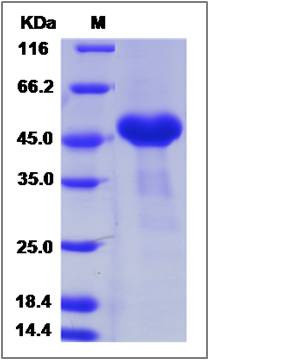Mouse CRELD1 Protein (His Tag)
AI843811
- 100ug (NPP2706) Please inquiry
| Catalog Number | P51149-M08H |
|---|---|
| Organism Species | Mouse |
| Host | Human Cells |
| Synonyms | AI843811 |
| Molecular Weight | The recombinant mouse CRELD1 comprises 344 amino acids and has a predicted molecular mass of 37.7 kDa. The apparent molecular mass of the protein is approximately 48 kDa in SDS-PAGE under reducing conditions. |
| predicted N | Gln 30 |
| SDS-PAGE |  |
| Purity | > 95 % as determined by SDS-PAGE |
| Protein Construction | A DNA sequence encoding the mouse CRELD1 (NP_598691.1) (Met1-Glu362) was expressed with a C-terminal polyhistidine tag. |
| Bio-activity | |
| Research Area | Cardiovascular |Heart |Cardiogenesis |Myocardial regeneration |
| Formulation | Lyophilized from sterile PBS, pH 7.4. 1. Normally 5 % - 8 % trehalose and mannitol are added as protectants before lyophilization. Specific concentrations are included in the hardcopy of COA. |
| Background | CRELD1 is a transmembrane glycoprotein. Epidermal growth factor(EGF)like domain exists in CRELD1. EGF-like repeats are a class of cysteine-rich domains that mediate interactions between proteins of diverse function. EGF domains are found in proteins that are either completely secreted or have transmembrane regions that tether the protein to the cell surface. CRELD1 contains a 333 amino acid acid (aa) extracellular domain (ECD), two tandem transmembrane segments, and a second ECD of 15 aa. Defects in CRELD1 may cause susceptibility to atrioventricular septal defect type 2 which results in a persistent common atrioventricular canal. |
| Reference |
